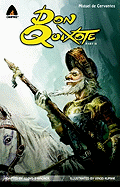 Title: Don Quixote: Part II
Title: Don Quixote: Part IIAuthor: Miguel de Cervantes
Wordsmith: Lloyd S. Wagner
Illustrator: Vinod Kumar
Colorist: Vinod S. Pillai
Publisher: Kalyani Navyug Media Pvt. Ltd.
Publication Date: August 9, 2011
Don Quixote: Part II begins after Don Quixote has returned home from his many adventures. He spends his days in solitude and remembrance until he is convinced by his friend and squire, Sancho Panza, and the bachelor, Samson Carrasco, to embark on a new adventure. His journey with Sancho Panza begins in high spirits but is crushed when he finds his love, Lady Dulcinea, has been enchanted and turned into a peasant woman who no longer recognizes him.
The journey continues with many high points for the Don Quixote and his squire, most of which occur during a long stay with a duke and duchess. The Duke and Duchess create elaborate pranks for Don Quixote to work through, all without his knowledge. When Don Quixote and Sancho Panza continue on their adventures they are confronted by a knight who challenges Don Quixote by declaring his lady is more beautiful than Lady Dulcinea. Once Don Quixote loses the joust he returns home with instructions from the victor to stay there for a full year. However, after returning home Don Quixote becomes ill and passes away in his bed surrounded by his friends and caretakers.
The humor was entertaining, and the illustrations were captivating. Even if the reader has never heard of the classic novel written by Miguel de Cervantes, this graphic novel gives relevant information on the classic novel and is constructed artistically so as to potentially peek enough interest on the character of Don Quixote for readers to want to read the longer text. However, being that the protagonist is an older knight, and the journey seems to be doomed to fail from the start, young adults reading this text may have difficulty relating to Don Quixote and his mission.
There are a couple of the characteristics present in the best examples of young adult literature in Don Quixote: Part II. The reading of the graphic novel is fast paced. It quickly takes the reader on the journey alongside Don Quixote and Sancho Panza. The language is mostly simple but does include an occasional higher level word. For example, the word “vanquished” is used several times throughout the text, and the word “bravado” is used on page 28 to describe Don Quixote’s behavior with a lion he wishes to fight. The graphic novel is fast-paced in that it moves from action to action with little to no lull time between.
In addition to being fast-paced, Don Quixote: Part II‘s character, Don Quixote, is overly optimistic most of the time. There are very few instances where he is not optimistic. In the very beginning of the novel when he decides to leave for more adventures, he is not concerned about his age or about the rumors that he is mad. He says, “Within four days, my dear friend Sancho, we shall be on the road again, doing good and combating evil” (10). There are times when Sancho is not as optimistic as Don Quixote, and Don Quixote is quick to point out his friend’s fear. “It seems to me, Sancho, that you want to be perched on that tree to watch the bull fight without danger” (22).
Don Quixote: Part II is missing many of the characteristics that define the best young adult literature examples. The most obvious missing characteristic is that it is not written from the point of view of a young adult; furthermore, the protagonist is a much older, past-his-glory-days, mad knight, making it difficult for young adult readers to identify with him. While Don Quixote is quick to take credit for his perceived accomplishments, a characteristic of the best of best in young adult literature, his accomplishments are not really his. Every time he believes he has accomplished a grand victory or deed, it is actually out of folly or prank.
For instance, on page 62 Don Quixote believes that he has defeated Malambruno, thus removing the beards from the duennas when, in actuality it was a grand prank produced by the Duke and Duchess. The text does not have various genres and subjects. The text contains only a few basic ideas and they do not change during the course of reading. The graphic novel also fails to include a diversity of ethnicities and cultures in both text and illustrations. Another major missing characteristic is that it does not deal with emotions that are important to young people. There are many emotions included and experienced: Don Quixote’s desire to accomplish more great deeds, he becomes depressed when his “so-called” loved one does not recognize him, he is boastful when he believes he has been victorious, and remorseful when he is defeated.
Though Don Quixote moves through all these relatable emotions, it is all done so out of folly and humor, distancing the feeling of relation between the reader and the character. A reader may relate to the feeling of depression when rejected by a lover, but Don Quixote’s rejection was because the peasant was not his real lover. That mistake made by a mad man makes the feeling of depression no longer relatable.
I would recommend this book as an introductory text to the classic novel originally written in 1605 by Miguel de Cervantes. Though the character of Don Quixote is not relatable, he is entertaining and amusing. Being that the graphic novel adapted by Lloyd S. Wagner was also enjoyable and comical, it would be a great introduction to the waggish qualities of Don Quixote and humorous adventures that Don Quixote and Sancho Panza experience. For teachers this would be a recommendable addition to a classroom library for middle and high school aged readers in both English and History classrooms.

No comments:
Post a Comment